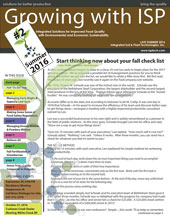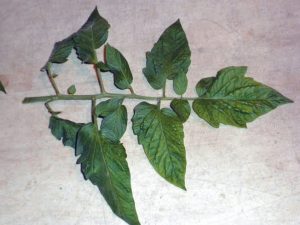

After preplant soil testing, proper application of granular nutrients and variety selection, timely plant tissue analysis is a tool with the potential to help you maximize yields of tomatoes, peppers, and other high value produce crops. Unlocking high plant yields and fruit quality requires up to date information on major and minor plant nutrient levels (N, P, K, Ca, Mg, S, B, Zn, Mn, Cu, Fe, and Si).

The key to good plant tissue analysis results is taking an appropriate sample and getting that sample to the lab while still in good condition. Knowing the correct parts of a plant, how much plant, and the right time to collect plant tissue are essential to this process. For example, useful tomato tissue testing requires 10-15 entire leaves, including the petiole taken from the most recently fully expanded leaves. These are usually the 4th or 5th leaf down from the growing tip. These leaves are now at their full size and have changed to a mature coloration. Leaves older then these store excess nutrients and can indicate plenty of some nutrients. The younger leaves are still taking up nutrients, thus may indicate a deficiency that does not exist. Collect leaves only from plants that appear average. Stunted plants or extra-large plants will be poor indicators of the overall nutrient needs of a planting.

Each sample should be all the same cultivar as mixed varieties will degrade the usefulness of the results as well. If necessary, send in multiple samples. One method to manage the number of tissue samples is to select one or more ‘indicator’ varieties, then base your nutrient applications on those results versus testing every variety separately. The downside to this is the potential to under or over feed varieties that have special needs. In high tunnel research plantings at Penn State University’s SEAREC, we’ve experienced certain heirloom (Arkansas Traveler) varieties that yielded little but a heavy leafy canopy when sharing a nutrient program with high yielders such as BHN 589.
Tomatoes go through three relatively different stages of growth during their lives. First the plant increases rapidly in size leading up to flowering. Sampling the plants at about 45 weeks after transplanting and before the first flowers emerge will give you a snapshot of early fruiting needs and go a long way to providing nutrient info to prevent yellow shoulders, blossom end rot, and other non-pathogen caused diseases. Two weeks later as the first fruit is setting is another critical window to tissue test, then sample every two weeks until the last fruit are ripening. The quickly growing fruits use quite a lot of calcium, magnesium and potassium along with other nutrients. Tissue analysis will help you to access your nutrient program and answer the question: Are you keeping up with your plant’s needs?
Note on tissue testing: In order to get the best results, pull your tissue samples at about the same time of day every time. Also, if your first test was on a sunny day, then try to stay with sunny days for pulling samples. One of the benefits of tissue testing comes from comparing past results to current results and deciding how your program needs to change. If you introduce variables such as cloudy days or early day samples versus late day samples, then it becomes difficult to compare results with any confidence. Always send your tissue samples in the paper envelopes provided by your laboratory, never plastic bags or brown lunch bags. It is not a problem if they wilt as the laboratory will dry them completely before processing. Samples that sweat in a plastic bag will grow grey mold, thus ruining any possibility of good results.
Peppers benefit from this same program, but require 25 leaves with petioles for a proper sample. Be sure to indicate the stage of the plants that you are testing on your sample submittal form. If in doubt, talk to the technical staff at your laboratory prior to collecting samples. Most labs are very helpful in making suggestions so they get the best samples and you get the best information. While running a proper testing program for tomatoes and bell peppers requires biweekly tissue testing, vine crop vine crop growers can get all of the information they need with testing twice; as the plants first start to runner and again at first fruit set.
Here are definitions of the most common and confused terms on tissue analysis results:
Deficiency: There is not enough of the nutrient present to meet even the most minimal requirements. In tomatoes, deficiencies are commonly found in Ca, Mg, and K. Shortages of these nutrients cause many of the common packing house losses as tomatoes are downgraded due to cracking, blossom-end rot, and yellow shoulders. Depending on the specific nutrient and the degree of deficiency, you may be able to make up the difference with foliar applications, injected fertilizers, or a combination of injected and foliar applied nutrients.
Sufficiency: This is probably the most common area of confusion when determining how much nutrient to apply, as sufficiency is often expressed as a percentage. At the low end of the scale (less than 50% sufficiency), there may be enough nutrient present to carry a small crop or light fruit load, but not enough to prevent all nutrient related maladies, or to grow a profitable crop. As the percentage moves closer to 100% sufficiency in all nutrients and they are kept in balance, the likelihood of a great crop that moves easily through packing increases. Nutrient balance is especially important as nutrients can compete for binding sites. The balance between K, Ca and Mg is one that directly impacts fruit quality.
Toxicity: Once a nutrient is above 100% sufficiency, some other nutrient is probably lacking as all nutrients are carried in plants in a balance. Toxicities can be expressed as phytotoxicity (leaf scorch or burn), or more often as deficiencies as other nutrients are no longer as available. In extreme cases, nutrient toxicities can kill plants.
Once you have your tissue test in hand, the next step is to determine what to apply, and when. Talk to your ISP Technology dealer for help in solving your nutrient challenges. The ISP plant foods, SiMag, MetaCal, and CalStore are all formulated to provide in-season nutrient solutions. They are all readily available for plant uptake and utilization, and have proven time and again to offer both effective and profitable results.
